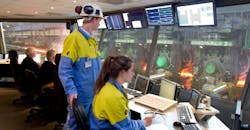For capital-intensive businesses, market shifts can make maintaining a steady return a serious challenge. Steel production is a prime example. The key to success – paying close attention to constantly improving the various key metrics separating middle of the road companies from the leaders.
While every company can afford improvement across these key metrics, Dr. Svend Lassen, head of reporting and data analytics in commercial and supply chain at Tata Steel Europe, saw data analytics as a good angle to improve these metrics and the customer experience, ultimately creating a plan consisting of various elements including forecasting, planning, and portfolio optimization. “We had a backlog of orders, with no real predictability around order completion. Also, responsiveness to supply chain issues were an issue,” says.
To address these issues, the global steel manufacturer unveiled its Future Value Chain digital transformation and digitalization effort in 2016-2017, with a key goal of leveraging data and intelligence to drive supply chain efficiency and increase revenue. And it’s worked. Since embarking on its digital transformation program, Tata Steel has increase revenue by over €10 ($13.8) million a year. Additionally, Tata now has a more robust system in supply chain design, enabling intervening and acting faster on deviations.
"We recognize collaboration across teams allows more flexibility in allocating resources and capacity, while generally improving delivery performance," he says. "There are various elements in terms of advanced analytics we introduced, which we also use in combination with forecasting and simulation capabilities relevant to formulate scenarios. The analytics now help drive sales and operations planning, demand and capacity forecasting, stock management as well as maintenance planning.”
Specifically, Tata has reduced its order backlog, experienced a significant improvement in delivery performance, and reduced stock levels by 19%. Tata also then received recognition from the World Economic Forum in 2018 on the list of the lighthouses manufacturing sites with the Netherlands recognizing the developments on the commercial and manufacturing sides, where it applies advanced analytics and new digital tooling.
As Future Value Chain has matured, the initiative has reached the point where business teams define the problem, resulting in teams taking ownership and eventually realizing the value – potentially one of the most important elements for success.
"If you look at engineers, manufacturing and supply chain professionals, they are already very close to data," he says. "However, the more relationship type people (sales, marketing, etc.), it is more difficult to convince, making the maturity of data/digital acceptance a bit distributed,” he says. “This is where the top-down voice and support to drive this journey forward has been a good vehicle in bringing everyone to the table."
According to Lassen, Future Value Chain has evolved into a transformation of the organization overall – not just the digital journey. “We have changed the way of working and become less hierarchical. We have become more an agile organization embedding decision making into the teams,” he says. “We are not the mainstream yet, this is still a transformation, but also spreading and embedding digital into the organization.”
Lessons learned
Understandably, Tata has had to make adjustments along the way.
For instance, Lassen quickly realized the important of having internal data and digital people onboard. “Initially, we worked a lot with external consultants and support,” he says. “They brought great value in helping us focus on the right things, and showing the value of driving the initiatives. But, eventually, we needed owners within the organization to maintain and run it.”
Additionally, paying attention to the data integration and the backend is crucial to avoiding a situation of tooling and individual islands. “We needed consistent processes, which again requires a lot of business attention, so our planning links up properly with the same data structures,” he says. “It helps to differentiate a business processes, while also growing the ecosystem with flexibility. There needs to be a strong focus also on process improvement, and then streamlining. While we are making progress, we're still improving the connectivity between the different planning paths.”
Lastly, governance and how units (i.e. commercial, manufacturing, R&D, procurement, downstream operations) operate together is important. “It’s important to have an approach and governance to align across the different functions, while still sharing data,” says Lassen.
Navigating the pandemic
While last year was challenging, it also underpins certain trends of volatility a large seasoned organization like Tata seen before. As such, it accelerated Tata’s journey, ensuring it had tools to cope with the volatility and quickly adjust plans and decision making. “We knew how to translate, but we needed to speed up,” says Lassen. “What we learned from the crisis was the need for an external view and market indicators such as what is happening on the purchasing market, what are the capacities, what's happening with our customers.”
Having a pulse on the market surfaced scenarios Lassen’s team could translate to better understand evolving steel demand.
Where to start?
Lassen tells IndustryWeek, the team started with use cases focused on creating value and speed – as well as winning over stakeholders. “We also need the proper foundations, having a data lake provided consistency and sustainable setup,” he says.
At Tata, the goal was to start with a use case focused on quickly generating value such as demand planning. “We are now planning demand on a such a granular level it is often better than customers even know themselves,” he says. “We know over the pattern of the year what demand will be, allowing us to accurately allocate assets and capacities. This provides us clear confidence when we say can meet the demand of our contracts, and also the demand of our strategic business.”
For company planning, Lassen’s team has models aligning with manufacturing and finance, making it the basis of annual plan. “It's become a structured and transparent process of planning to help define strategic customers, allowing us to determine which customers to serve from which supply chain.”
Another use case focuses on helping when sales teams cannot recruit orders to meet allocated tonnage. “We can apply advanced analytics to recognize if the order book is falling short, allowing us to put it into a trading desk solution to find alternative customers to take the volume,” he says. “We have seen clear benefits in terms of improved pricing.”
About the Author
Peter Fretty
Technology Editor
As a highly experienced journalist, Peter Fretty regularly covers advances in manufacturing, information technology, and software. He has written thousands of feature articles, cover stories, and white papers for an assortment of trade journals, business publications, and consumer magazines.

